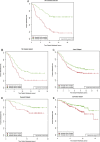A gene signature for late distant metastasis in breast cancer identifies a potential mechanism of late recurrences
- PMID: 23910573
- PMCID: PMC5528450
- DOI: 10.1016/j.molonc.2013.07.006
A gene signature for late distant metastasis in breast cancer identifies a potential mechanism of late recurrences
Abstract
Introduction: Breast cancer risk of recurrence is known to span 20 years, yet existing prognostic signatures are best at predicting early recurrences (≤ 5 years). There is a critical need to identify those patients at risk of late-relapse (>5 years), in order to select potential candidates for further treatment and to identify molecular targets for such treatment.
Methods: A total of 252 breast primary tumors were selected at the Netherlands Cancer Institute from a retrospective series of ER+, HER2- breast cancer patients with a follow-up of at least 10 years. Gene expression analysis was performed using Agilent 4x44K microarrays. Patients were classified in 3 groups: no relapse (M0); relapse before 5 years (M0-5) or after 5 years (M5-15). We assessed the correlation of clinico-pathological variables with late Distant Metastases (DM). We divided the patient series into a training set of untreated patients (n = 140) and a test set of treated patients (n = 112), to investigate whether a gene-signature or single genes could be identified for predicting late DM. Pathway level late DM correlates were identified using PARADIGM and DAVID.
Results: Of the clinico-pathologic variables tested, only lymph node status associated with late DM. A 241-gene signature developed on the NKI training set was able to classify M5-15 patients in the test set with a sensitivity of 77% and a specificity of 33% (AUC 0.654). This signature showed enrichment in genes involved in immune response and extracellular matrix. An alternative analysis of individual genes identified CH25H as an independent predictor of distant metastasis in our patient series.
Conclusions: We identified a gene signature for late metastasis in breast cancer. Our data are consistent with a model in which suppressed anti-tumoral immunity enables dormant tumor cells to re-enter the cell cycle to form metastases in response to extrinsic events in the microenvironment.
Keywords: Breast cancer; CH25H gene; Gene expression profiling; Late distant metastasis; MammaPrint; Microenvironment; PARADIGM; Prognostic.
Copyright © 2013 Federation of European Biochemical Societies. Published by Elsevier B.V. All rights reserved.
Figures





References
-
- Bauman, D.R. , Bitmansour, A.D. , McDonald, J.G. , Thompson, B.M. , Liang, G. , Russell, D.W. , 2009. 25-Hydroxycholesterol secreted by macrophages in response to toll-like receptor activation suppresses immunoglobulin A production. Proc. Natl. Acad. Sci. U S A. 106, (39) 16764–16769. - PMC - PubMed
-
- Burstein, H.J. , Griggs, J.J. , 2012. Deep time: the long and the short of adjuvant endocrine therapy for breast cancer. J. Clin. Oncol.. 30, (7) 684–686. - PubMed
-
- Buyse, M. , Loi, S. , van't Veer, L. , Viale, G. , Delorenzi, M. , Glas, A.M. , d'Assignies, M.S. , Bergh, J. , Lidereau, R. , Ellis, P. , 2006. Validation and clinical utility of a 70-gene prognostic signature for women with node-negative breast cancer. J. Natl. Cancer Inst.. 98, (17) 1183–1192. - PubMed
-
- Castano, Z. , Tracy, K. , McAllister, S.S. , 2011. The tumor macroenvironment and systemic regulation of breast cancer progression. Int. J. Dev. Biol.. 55, (7–9) 889–897. - PubMed
-
- Chia, S.K. , Wolff, A.C. , 2011. With maturity comes confidence: EBCTCG tamoxifen update. Lancet. 378, (9793) 747–749. - PubMed
Publication types
MeSH terms
LinkOut - more resources
Full Text Sources
Other Literature Sources
Research Materials
Miscellaneous

